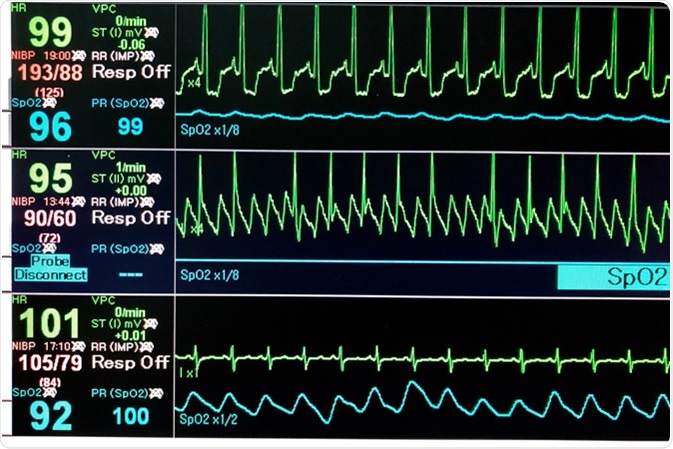Bradycardia is defined heart rate less than the lower limit of normal for age or slow heart rate. A normal heart rate in children varies based on age as well as the level of physical activity. In the age group of 0 – 3 years, heart rate less than 100 beats per minute (bpm) is considered as bradycardia.
Skip to:

Vital sign EKG monitor. Image Credit: Duangnapa Kanchanasakun / Shutterstock
The conduction system of the heart
The conduction system of the heart includes the SA node, AV node, bundle of His, bundle branches, and Purkinje fibers.
In a normal heart, electrical conduction initiates in the sinus node, which is a group of specialized cells located in the upper right portion of the heart. Sinus node is also referred to as the natural pacemaker of the heart due to its ability to spontaneously initiate the electrical impulses that leads to the contraction of the heart.
After its initiation in the sinus node, electric impulses travel through both the atrium (upper chamber of the heart) to the atrioventricular node or AV node in the middle of the heart. From the AV node, the impulse spreads through the ventricles (lower chamber of the heart) and as the electric impulse pass through the ventricles, heart muscle contracts.
What are the causes of infantile bradycardia?
Bradycardia can be caused by dysfunction of certain intrinsic factors of the heart or irregularities in the heart’s conduction system. Bradycardia can also develop by external factors acting on a normal heart, such as the use of certain medications.
- Hypoxemia – Hypoxemia an abnormally low level of oxygen in the blood, is the most common cause of sinus bradycardia. Hypoxemia causes depression of the sinus node or a conduction block. Hypoxemia may be caused by congenital heart defects, lung disease or respiratory failure.
- Metabolic causes - Metabolic acidosis is another common cause of infantile bradycardia. Metabolic acidosis is a condition characterised by increase in plasma acidity. This occurs due to accumulation of acid in the body. It can also occur when the kidneys are unable to excrete enough acid from the body. Metabolic disorders such as hypothyroidism or a low thyroid level is also a common cause ofbradycardia in children.
- Drug induced – Drugs such as beta blockers are frequently used to treat hypertension during pregnancy. Even though these drugs are considered safe for use in pregnancy, they have a high propensity to cross the placenta and cause physiologic changes to the fetus. Neonates born to mothers who required beta blocker therapy during pregnancy are at an increased risk of developing neonatal bradycardia.
- Following heart surgery - Sinus bradycardia may also occur in children who have undergone open heart surgery. It is more commonly observed in those with surgery involving the area around the sinus node. Due to the damage, sinus node may fire the electric impulses slowly than normal, which leads to slow heart rate or sinus bradycardia.
What are the signs and symptoms of infantile bradycardia?
Most children with sinus bradycardia are asymptomatic i.e. present with no particular symptoms. The appearance of symptoms depends on the severity of the bradycardia, any related heart problems and the child’s age.
Infants may present with symptoms such as failure to thrive or arrested physical growth. The child may also express exhaustion with feeds - refuses feeds or may be too tired for feeds. The older child may feel excessively fatigued or tired, especially during exercising or physical activity.
Syncope or fainting may occur in extreme cases. Severe cases present with cardiogenic shock, which is characterised by loss of consciousness, weak pulse, decreased mental status, hypotension and decreased urine output.
How is infantile bradycardia diagnosed?
The first step in the evaluation of infantile bradycardia is performing an electrocardiogram. The electrocardiogram helps the doctor identify the exact cause of bradycardia, and the severity of the condition. Patients with abnormal heart beats but a normal electrocardiogram might need Holter monitoring. Holter monitor is a device used to keep track of heart rhythm over the course of a full day. It can detect bradycardia and the specific conduction abnormality.
Thyroid function tests should be done to check out for hypothyroidism - a common cause of bradycardia. Assessment of arterial blood gasses can help to detect acidosis and hypoxemia.
Cardiac electrophysiology studies may be required in some cases to detect the abnormal heartbeat or an area of abnormal heart tissue.
What are the treatment options for infantile bradycardia?
Treatment options for infantile bradycardia depend on the underlying cause.
Bradycardia associated with a complete heart block requires the use of an artificial pacemaker.
Symptomatic patients are treated with drugs such as atropine or isoproterenol. If metabolic acidosis is the cause of bradycardia, the origin of acidosis needs to be determined and corrected. Bradycardia causes by hypothyroidism may necessitate thyroid replacement medication.
Asymptomatic patients require to be monitored closely and underlying causes of the bradycardia should be corrected.
Further Reading
Last Updated: Aug 15, 2019